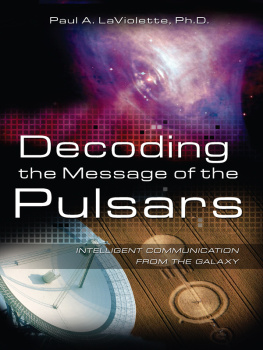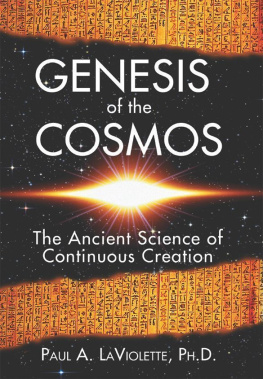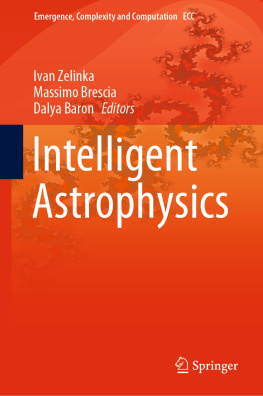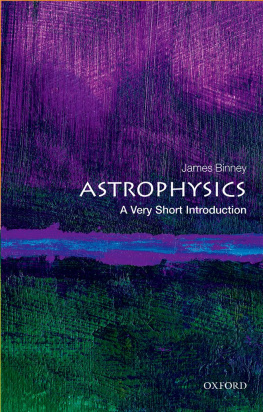DECODING THE MESSAGE OF THE PULSARS
Intelligent Communication from the Galaxy
Paul A. LaViolette, Ph.D.

ACKNOWLEDGMENTS

I would like to thank my father, Fred, and also Tom Valone for the long hours they both spent helping me edit this manuscript. I would also like to thank Joscelyn Godwin; Jackie Panting; my sister, Mary; and mother, Irene, for their helpful comments on the manuscript, and Geri Davisson for her help as well.
CONTENTS

PREFACE

For decades SETI astronomers have been searching the sky for radio signals of extraterrestrial intelligence origin but have found nothing. Perhaps the problem is that they are looking for the wrong type of signal. They have been seeking discrete frequency transmissions similar to terrestrial AM or FM radio signals. But there is no guarantee that another civilization would be using this particular method of communication. Broadband transmissions, covering the entire radio frequency spectrum, would be a more logical choice because they would be more easily detected regardless of which frequency ones radio telescope happened to be tuned to. Such broadband emission, called synchrotron radiation, is readily produced by magnetically decelerating a beam of cosmic ray electrons. By arranging that the electrons track in a straight line as they decelerate, the synchrotron radiation can be confined to a narrow beam that has minimal decrease of its intensity over interstellar distances, thereby ensuring that the target civilization will be receiving a strong signal.
This kind of radio transmission essentially describes the signals that astronomers routinely observe coming from pulsars. In particular, there is considerable evidence to suggest that these signals are artificial. Indeed, they are the most complex ordered phenomenon known to astronomy, and to this date, they have not been adequately accounted for by any natural-cause model. The neutron star lighthouse model, for example, falls far short of this challenge. Many astronomers, though, will experience difficulty relinquishing the paradigm they have come to accept, even when confronted with its shortcomings.
In reading this book, keep in mind that several sets of relationships must be taken into account to fully understand the symbolic message that the pulsar network is conveying. One part ties in with another to form a complete picture. Thus, it is helpful to contemplate these findings as a whole. It is also useful to read the books Earth Under Fire and Genesis of the Cosmos, as they provide background material essential to understanding the pulsar message.
ONE
THE PULSAR ENIGMA

One other thing it can be is an intelligent civilization attempting to communicate with other worlds, because everybody has said thats how youd mark yourself. You do something that cant be done in nature. You make the pulse rate of a nearby pulsar exactly right, not deviating in the least year after year.
FRANK DRAKE, 1974
Discovery
It was July 1967. The worlds first scintillation radio telescope had just been completed, a device that would allow astronomers to detect rapidly varying radio emissions coming from distant stars. Cambridge University graduate student Jocelyn Bell and her astronomy professor, Anthony Hewish, were making final adjustments to the field of radio aerials that lay stretched out across the English countryside. Little did they know that within a month Jocelyn would stumble upon one of the most important astronomical discoveries of the century. They had finished scanning an area of the sky located in the direction of the constellation of Vulpecula. Jocelyn was looking over the yards and yards of pen chart data that scrawled the signals from their antenna array and noticed something quite unusual. One of the radio sources whose radio signal twinkling they had been observing appeared to be emitting a steady series of radio pulses, or beeps, each lasting a few hundredths of a second. Hewish at first dismissed the pulses as radio interference from a terrestrial source such as sparking from a passing automobile. The signal had faded and could not be detected on subsequent observations, but one night it reappeared. After several months of observation, seeing that the signal came from a fixed location in the sky, he became convinced that they had detected a new kind of astronomical source.
At the end of November, after obtaining a suitable fast-response chart recorder, they were able for the first time to get an accurate fix on the timing of the pulses. Six hours of observations had shown that the pulses had a very regular recurrence period of 1.337330.00001 seconds. Additional months of observation added two more decimal places to the precision of the source, and today we know its period to better than six parts per trillion, yielding a pulsation period of precisely 1.3373011922690.000000000006 seconds per cycle! This discovery caused quite a stir among the projects scientists. Nothing like it had ever been seen before. It seemed to them that they may have detected signals being sent from an alien civilization. Months of careful observation had revealed that the radio source lay about two thousand light-years away. The idea that the object was a radio beacon operated by extraterrestrial intelligence (ETI) was seriously considered, for this was the first time in the history of astronomy that a source of such precise regularity had been encountered. In fact, they initially named this source LGM-1, the acronym LGM standing for Little Green Men.
Near the end of December, Jocelyn discovered a second pulsating radio source in the constellation of Hydra, which lay in an opposite part of the sky. This one, which had a period of 1.2737635 seconds, was later christened LGM-2. With the discovery of this second source, the Cambridge astronomers began to doubt their ETI hypothesis. Since the two pulsars were found to be separated from one another by over 4,000 light-years, they figured that if they were ETI transmitters, they would necessarily have been built by different civilizations. But then it seemed to them very unlikely that more than one civilization would have chosen to communicate with us at this particular point in time and in addition use a similar method of sending precisely timed pulses.
Fearing they would be inundated with reporters if their discovery became known to the public, the astronomers kept their find a tightly guarded secret until February, when they submitted a paper about it to Nature magazine.
Multiple-source ETI communication, however, would not be all that unusual if the signals were coming from several intercommunicating civilizations, forming a kind of galactic collective or commune. In such a case, the idea of several communicators being on line and using similar methods of transmission would seem rather plausible. Today many scientists interested in the Search for Extraterrestrial Intelligence, an endeavor known as SETI, believe that such a galactic commune could very well exist. For example, the MIT radio astronomer professor Alan Barrett was one scientist who in the early 1970s was quoted by the
Next page









